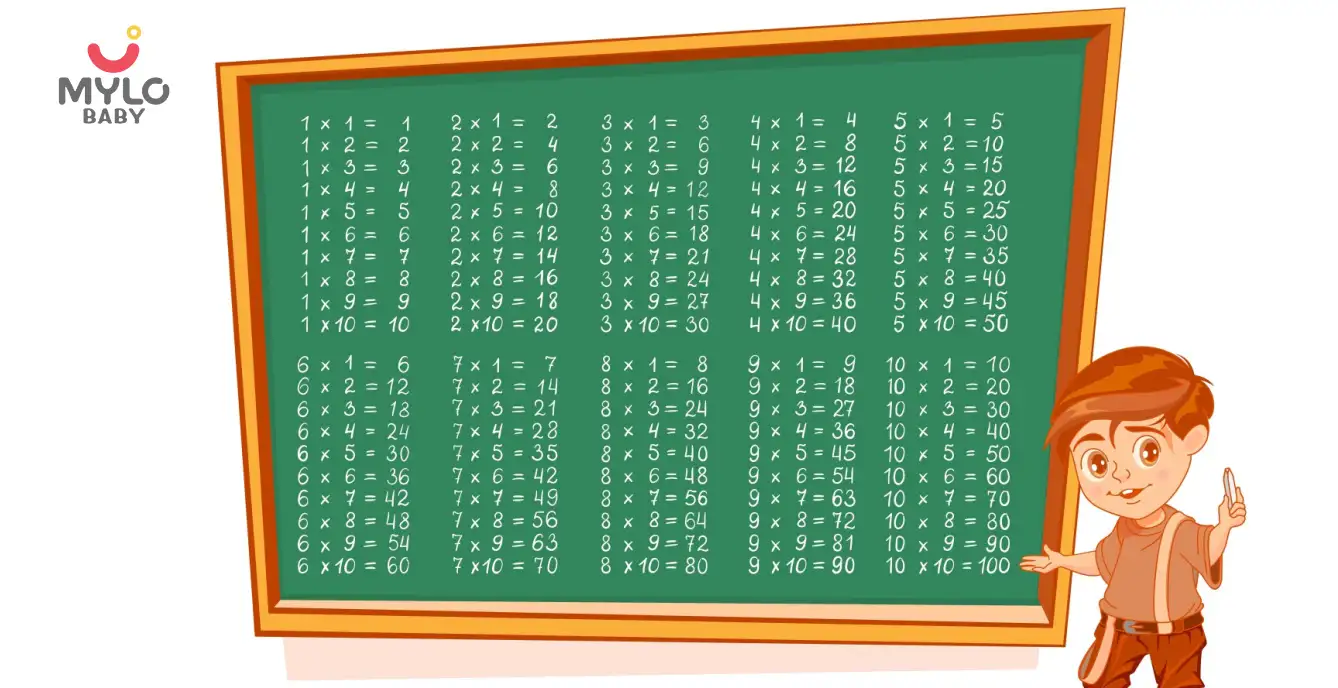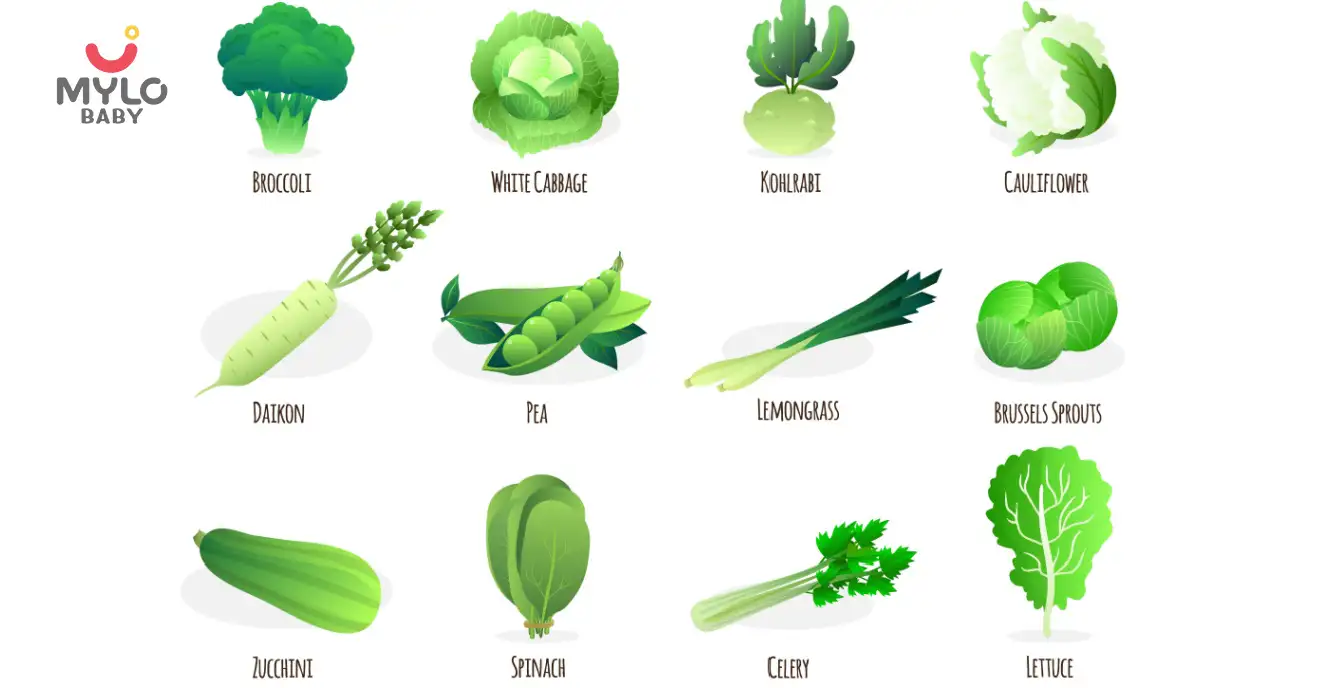Home

Tables 1 to 10: A Complete Overview for Children
In this Article

Pregnancy
Tables 1 to 10: A Complete Overview for Children
Updated on 22 January 2024
Are you ready to embark on an exciting journey of teaching children the fundamentals of multiplication through tables 1 to 10? We know that helping kids grasp these essential building blocks of math can sometimes be a challenge, but fear not - we're here to make it a breeze for you! Get ready to discover engaging techniques and valuable tips to make learning tables a fun and rewarding experience for your little learners in this article.
When should you start teaching your child maths table 1 to 10?
Teaching multiplication tables to children is an essential part of their mathematical development. Many parents wonder when is the right time to start teaching their child tables 1 to 9. The answer is that it varies from child to child, but generally, it is recommended to start introducing multiplication tables around the age of 6 or 7.
At this age, children have a solid foundation in basic arithmetic and can grasp the concept of multiplication. However, it's important to remember that every child is different, and some may be ready to learn tables earlier or later than others.
There are a few signs that can help you determine if your child is ready to start learning tables. If they have a good understanding of addition and subtraction, can count to 10 or higher, and show an interest in numbers and patterns, it may be a good time to introduce multiplication tables.
What are the benefits of teaching children multiplication table 1-10?
Here are some advantages of teaching your children 1 to 10 table chart:
1. Improved mental math skills
Learning multiplication tables helps children develop strong mental math skills. It enables them to quickly calculate and solve mathematical problems in their head, which can be useful in everyday life situations.
2. Enhanced problem-solving abilities
By memorizing maths tables 2 to 10, children learn to analyze and solve problems more efficiently. They develop the ability to break down complex problems into smaller, more manageable parts, which is a valuable skill in various areas of life.
3. Increased confidence
Mastering multiplication tables gives children a sense of accomplishment and boosts their confidence in their mathematical abilities. They become more self-assured in their problem-solving skills, leading to a positive attitude towards math.
4. Better understanding of higher-level math concepts
Multiplication is the foundation of many advanced mathematical concepts, such as division, fractions, and algebra. By mastering maths table 1 to 10, children build a strong base for understanding these higher-level concepts.
5. Improved logical thinking
Learning multiplication tables helps children develop logical thinking skills. They learn to recognize patterns and relationships between numbers, which enhances their ability to solve problems and think critically.
You may also like: The A-Z Guide to Identifying Vegetables Name in English for Children
Tables 1 to 10
Tables up to 10 are the basic multiplication tables that every child should learn. These tables provide the foundation for understanding multiplication and are essential for further mathematical development. Here is a breakdown of each table:
1 x 1 = 1
1 x 2 = 2
1 x 3 = 3
1 x 4 = 4
1 x 5 = 5
1 x 6 = 6
1 x 7 = 7
1 x 8 = 8
1 x 9 = 9
1 x 10 = 10
2 x 1 = 2
2 x 2 = 4
2 x 3 = 6
2 x 4 = 8
2 x 5 = 10
2 x 6 = 12
2 x 7 = 14
2 x 8 = 16
2 x 9 = 18
2 x 10 = 20
3 x 1 = 3
3 x 2 = 6
3 x 3 = 9
3 x 4 = 12
3 x 5 = 15
3 x 6 = 18
3 x 7 = 21
3 x 8 = 24
3 x 9 = 27
3 x 10 = 30
4 x 1 = 4
4 x 2 = 8
4 x 3 = 12
4 x 4 = 16
4 x 5 = 20
4 x 6 = 24
4 x 7 = 28
4 x 8 = 32
4 x 9 = 36
4 x 10 = 40
5 x 1 = 5
5 x 2 = 10
5 x 3 = 15
5 x 4 = 20
5 x 5 = 25
5 x 6 = 30
5 x 7 = 35
5 x 8 = 40
5 x 9 = 45
5 x 10 = 50
6 x 1 = 6
6 x 2 = 12
6 x 3 = 18
6 x 4 = 24
6 x 5 = 30
6 x 6 = 36
6 x 7 = 42
6 x 8 = 48
6 x 9 = 54
6 x 10 = 60
7 x 1 = 7
7 x 2 = 14
7 x 3 = 21
7 x 4 = 28
7 x 5 = 35
7 x 6 = 42
7 x 7 = 49
7 x 8 = 56
7 x 9 = 63
7 x 10 = 70
8 x 1 = 8
8 x 2 = 16
8 x 3 = 24
8 x 4 = 32
8 x 5 = 40
8 x 6 = 48
8 x 7 = 56
8 x 8 = 64
8 x 9 = 72
8 x 10 = 80
9 x 1 = 9
9 x 2 = 18
9 x 3 = 27
9 x 4 = 36
9 x 5 = 45
9 x 6 = 54
9 x 7 = 63
9 x 8 = 72
9 x 9 = 81
9 x 10 = 90
10 x 1 = 10
10 x 2 = 20
10 x 3 = 30
10 x 4 = 40
10 x 5 = 50
10 x 6 = 60
10 x 7 = 70
10 x 8 = 80
10 x 9 = 90
10 x 10 = 100
1 to 10 Table Chart for Easy Learning

To help children learn multiplication table 1-10 more easily, a visual representation can be used. A table chart 1 to 10 is a simple and effective tool that provides a visual aid for learning multiplication tables. The chart can be displayed in the child's study area or classroom, serving as a constant reference for practicing and reinforcing multiplication skills.
Tips and tricks to teach maths table 1 to 10
Teaching multiplication tables can be a challenging task, but with the right approach and strategies, it can be made easier and more enjoyable for children. Here are seven tips and tricks to help you teach tables 1 to 10 effectively:
1. Make it fun
Incorporate games, puzzles, and interactive activities into the learning process. This makes learning multiplication tables more engaging and enjoyable for children.
2. Use visual aids
Visual representations, such as charts, diagrams, and manipulatives, can help children visualize multiplication concepts and patterns. These aids enhance understanding and retention of the tables.
3. Encourage practice
Regular practice is key to mastering maths tables 2 to 10. Provide opportunities for children to practice through worksheets, online exercises, or flashcards.
4. Relate to real-life situations
Help children see the practical applications of multiplication in everyday life. For example, ask them to calculate the total number of items in a given number of groups or the cost of multiple items.
5. Break it down
Teach tables one at a time, starting with table 1 and gradually progressing to table 10. Breaking down the learning process into smaller, manageable parts makes it less overwhelming for children.
6. Provide positive reinforcement
Recognize and praise children's efforts and achievements in learning multiplication tables. Positive reinforcement motivates children and boosts their confidence.
7. Be patient
Learning multiplication tables takes time and practice. Be patient with children and provide support and guidance throughout the learning journey.
Key Takeaways
Teaching children multiplication tables 1 to 10 is an important part of their mathematical development. It is recommended to start introducing multiplication tables around the age of 6 or 7, but every child is different, and readiness may vary. To facilitate learning, the 1 to 10 table chart can be used as a visual aid. Additionally, incorporating fun, using visual aids, encouraging practice, relating to real-life situations, providing positive reinforcement, and being patient are effective strategies for teaching tables to children.



Written by
Anandita Sharma
Drawing on more than a decade of expertise in administration, Anandita Sharma currently serves as a content operations e
Read MoreGet baby's diet chart, and growth tips

Related Articles
Related Questions
Hello frnds..still no pain...doctor said head fix nhi hua hai..bt vagina me pain hai aur back pain bhi... anyone having same issues??

Kon kon c chije aisi hai jo pregnancy mei gas acidity jalan karti hain... Koi btayega plz bcz mujhe aksar khane ke baad hi samagh aata hai ki is chij se gas acidity jalan ho gyi hai. Please share your knowledge

I am 13 week pregnancy. Anyone having Storione-xt tablet. It better to have morning or night ???

Hlo to be moms....i hv a query...in my 9.5 wk i feel body joint pain like in ankle, knee, wrist, shoulder, toes....pain intensity is high...i cnt sleep....what should i do pls help....cn i cosult my doc.

Influenza and boostrix injection kisiko laga hai kya 8 month pregnancy me and q lagta hai ye plz reply me

Related Topics
RECENTLY PUBLISHED ARTICLES
our most recent articles

Vitamins & Supplements
Can Herbal Supplements Boost Your Chances of Getting Pregnant?

Diet & Nutrition
Sesame Seeds in Pregnancy: Nutritional Value, Benefits & Side Effects

Pregnancy Complications
Betnesol Injection in Pregnancy: The Ultimate Guide to Benefits and Risks

Government Policies & Schemes
Pradhan Mantri Matru Vandana Yojana (PMMVY) to Give Rs 5,000 to Pregnant Women

Education
The A-Z Guide to Identifying Green Vegetables Names for Kids

Diet & Nutrition
Anjeer in Pregnancy: Benefits & Side Effects of Eating Figs
- Black Grapes During Pregnancy: Benefits & When to Avoid
- The Ultimate Guide to the Best Series on Hotstar- Hindi
- The Ultimate Guide to Teaching Children Tables 1 to 20
- Thought of the Day for Kids to Spark Imagination & Positivity
- 100 Thought of the Day to Brighten and Motivate Young Minds
- Orange in Pregnancy: Health Benefits, Side Effects & Precautions
- Radish in Pregnancy: Benefits and Safety Precautions
- Top 10 Pakistani Dramas That Will Keep You Hooked
- New Born Baby Astrology: What Does Your Baby's Zodiac Sign Say About Their Personality
- Pelvic Pain: Causes, Symptoms and Treatment Options
- Brown Discharge: Causes, Symptoms and When to Seek Help
- Baby Hair Style: A Complete Guide for Trendy Parents
- Breast Pain During Ovulation: A Comprehensive Guide on Causes and Solutions
- PCOS Ultrasound: What to Expect During the Procedure


AWARDS AND RECOGNITION

Mylo wins Forbes D2C Disruptor award

Mylo wins The Economic Times Promising Brands 2022
AS SEEN IN
















- Mylo Care: Effective and science-backed personal care and wellness solutions for a joyful you.
- Mylo Baby: Science-backed, gentle and effective personal care & hygiene range for your little one.
- Mylo Community: Trusted and empathetic community of 10mn+ parents and experts.
Product Categories
baby carrier | baby soap | baby wipes | stretch marks cream | baby cream | baby shampoo | baby massage oil | baby hair oil | stretch marks oil | baby body wash | baby powder | baby lotion | diaper rash cream | newborn diapers | teether | baby kajal | baby diapers | cloth diapers |








